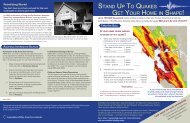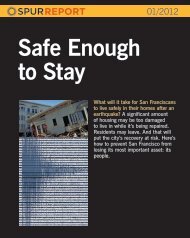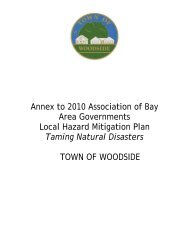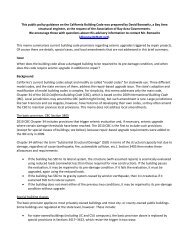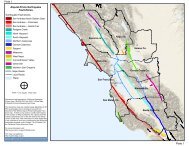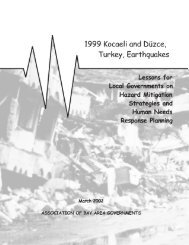Airport Liquefaction Susceptibility Analysis Report - ABAG ...
Airport Liquefaction Susceptibility Analysis Report - ABAG ...
Airport Liquefaction Susceptibility Analysis Report - ABAG ...
Create successful ePaper yourself
Turn your PDF publications into a flip-book with our unique Google optimized e-Paper software.
Fugro Consultants, Inc.<br />
Project No. 04.79221200<br />
generally advance samplers that extract materials for visual inspection and laboratory testing.<br />
One type of samples is the SPT and it is designed to measure of the resistance of soil under a<br />
set of controlled conditions; a soil sampler of a known diameter is driven into the ground using a<br />
140 pound hammer that is dropped from a known height. The number of blows required to<br />
advance the sampler a total of 12 inches into the ground is recorded and is known as the<br />
standard penetration resistance, or the N-value. High N-values correspond to high consistency<br />
(fine grained) or high density (coarse grained) soils, while low N-values correspond to low<br />
consistency, or low density soils. The CPT is another in-situ test that measures a soil’s<br />
response to an instrumented cone that is pushed into the subsurface. The test measures the<br />
friction and penetration resistance as the cone is advanced into the soil at a controlled rate. One<br />
advantage of the CPT method is that a continuous measure of the soil column is possible<br />
(conversely, SPT’s have spacing in-between test intervals – typically 2.5 to 5 feet). Other types<br />
of tests can be used to estimate liquefaction susceptibility and include: shear wave velocity (e.g.<br />
Andrus and Stokoe, 1999, Andrus, 2000; Andrus et al., 2004), or dynamic laboratory testing of<br />
undisturbed soil samples. These alternative testing techniques area comparably expensive; as<br />
a result, the SPT and CPT techniques are the predominant testing method employed when<br />
collecting data for liquefaction susceptibility hazard analyses.<br />
Because the Simplified Procedure has been extensively used and studied, the method has<br />
benefited from revisions and refinements that have improved the level of overall analysis (e.g.<br />
Seed et al., 1982, 1983, 1985; Robertson and Wride, 1997; Youd et al., 2001; Idriss and<br />
Boulanger, 2004, Cetin et al., 2004b). For this study, the 2001 NCEER recommendations for<br />
employing the Simplified Procedure are used to analyze liquefaction potential at San Francisco,<br />
Oakland, Moffett, and Buchanan airports.<br />
3.2.4 Preparation of Settlement Maps<br />
In addition to calculating factor of safety against liquefaction, our assessment also includes<br />
evaluation of liquefaction-induced reconsolidation settlements. <strong>Liquefaction</strong> induced<br />
settlements were calculated using the recommendations of Ishihara and Yoshimine (1992).<br />
Settlement maps were developed for San Francisco, Oakland, Moffett, and Buchanan airports.<br />
It should be noted that many of the borings at each airport are relatively shallow, with depths of<br />
penetration as low as 5 to 10 feet below ground surface. Because liquefaction induced<br />
settlements can occur at depths up to 50 or 80 feet, we only calculate estimates of settlement<br />
for borings that exceed 30 feet penetration. The shallower borings are omitted because the<br />
analytical results could be misinterpreted and promote underestimation of the settlement<br />
hazard. A discussion of these results is included in Section 5.0.<br />
7<br />
May 31, 2013



